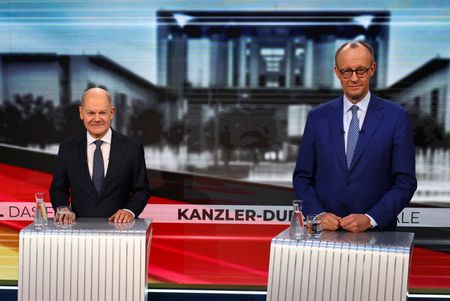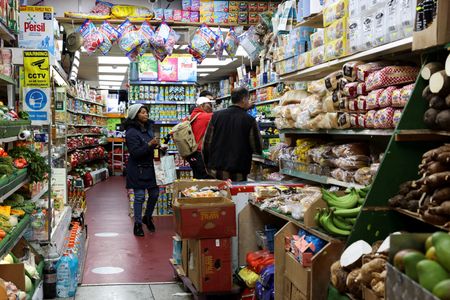By Thomas Escritt
BERLIN (Reuters) – Germans go to the polls on Sunday in a snap election called after the collapse of Chancellor Olaf Scholz’s three-way coalition. This is how Germany’s election system works:
WHAT IS GERMANY’S HYBRID VOTING SYSTEM?
Germany’s reformed voting system aims to blend British- or American-style single-member constituencies with the proportionality characteristic of most continental European countries.
Under the old system, proportionality was ensured by topping up parliament with extra seats after winners were found in each of 299 constituencies. This ensured parties held seats in line with their share of the vote, regardless of the distribution of constituency seats.
In 2021, that led to a parliament of 735 seats, one of the largest legislatures in the world.
A new law, introduced in 2023, fixes parliament at 630 seats – between Britain’s lower House of Commons and Turkey’s National Assembly in world rankings – and prioritises proportionality over individual member seats.
Now, if a party wins a share of seats that is greater in proportion to their share of the national vote, some constituencies will be left vacant, starting with those where the winning candidates have the narrowest margin of victory.
The change may hurt parties that are traditionally strong in single-member constituencies – in particular the Christian Social Union (CSU), the Bavarian sister party of the Christian Democrats (CDU) whose leader Friedrich Merz is tipped to become the next chancellor after the election.
HOW DOES THE 5% THRESHOLD WORK?
Under rules designed to prevent the kind of chaotic and fragmented parliaments that in the 1930s helped fuel the disastrous rise to power of Adolf Hitler’s Nazis, parties must in general get 5% of the national vote to enter parliament.
But under a rule that had been scrapped in the new law before being restored by a court ruling, parties that win three constituency seats are entitled to seats corresponding to their vote share even if it is below 5%.
In 2021, that saved the Left party, which, thanks to three members with strong regional bases in eastern Germany, got 39 seats.
The combination of the 5% threshold, the three-seat exception, and an unusually competitive party landscape with many smaller parties jostling for position makes for a particularly unpredictable result this time.
Polls put the neo-liberal Free Democrats, whose departure from Chancellor Olaf Scholz’s three-way coalition precipitated the snap election, on about 4-5%, while the Left is seen on 6-7% and its splinter party, the upstart Sahra Wagenknecht Alliance(BSW), on 4-5%.
The Free Voters, strong rivals to the CSU in Bavaria, are far short of the 5% threshold nationally but have a chance of winning three member constituencies, which would put them in the Bundestag for the first time.
HOW COULD PARLIAMENT LOOK?
With a highly competitive party landscape and a complex electoral system, the parliament could comprise anywhere from four to eight parties. The first scenario would yield the most consolidated Bundestag since 2017, while the latter would mark the most diverse in modern German history.
That means the distribution of power in the new parliament is extremely hard to predict and that Merz will most likely need a coalition partner – either Scholz’s Social Democrats or the Greens or maybe both – to build a majority government.
The far-right Alternative for Germany (AfD), currently in second place in most polls on around 20%, is unlikely to be part of any coalition government as all other parties have ruled out working with a party they regard as undemocratic.
(Reporting by Thomas Escritt and Riham Alkousaa; Editing by Bernadette Baum, Gareth Jones and Hugh Lawson)













